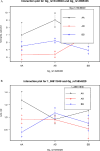Domestication effects on crowing in chickens: variation between wild and captive red junglefowl and domestic white Leghorn and the genetic architecture of crowing vocalizations
- PMID: 40370017
- PMCID: PMC12079126
- DOI: 10.1098/rstb.2024.0199
Domestication effects on crowing in chickens: variation between wild and captive red junglefowl and domestic white Leghorn and the genetic architecture of crowing vocalizations
Abstract
The crowing of the male chicken is a charismatic example of vocal display in a bird. It is regarded as the main territorial announcement of the ancestral red junglefowl. The call has been preserved throughout domestication, although several of its elements have been altered. To assess these alterations, we assayed crowing spectrograms from wild and captive-held red junglefowl populations from India, along with two red junglefowl populations held in long-term captivity in Sweden, and a domestic white Leghorn breed. We find consistent differences between the different Indian red junglefowl and the domestic white Leghorn for a range of characteristics, including the duration of the last syllable and the number of formants and their frequency in the last and second-to-last syllable. To analyse the genetic architecture of crowing vocalization, we performed a quantitative trait loci (QTL) experiment using a wild × domestic advanced intercross to identify QTL that explained a large percentage of the variation present for the duration of the last syllable and the number of formants in the second to last syllable. With this study we thus demonstrate consistent differences in red junglefowl and white Leghorn chickens and identify a relatively simple genetic architecture for some of these traits.This article is part of the theme issue 'Unravelling domestication: multi-disciplinary perspectives on human and non-human relationships in the past, present and future'.
Keywords: crowing; domestication; quantitative trait locus.
Conflict of interest statement
We declare we have no competing interests.
Figures


Similar articles
-
Assessing the comparative effects of interventions in COPD: a tutorial on network meta-analysis for clinicians.Respir Res. 2024 Dec 21;25(1):438. doi: 10.1186/s12931-024-03056-x. Respir Res. 2024. PMID: 39709425 Free PMC article. Review.
-
Comparative Analysis of Runs of Homozygosity Islands in Indigenous and Commercial Chickens Revealed Candidate Loci for Disease Resistance and Production Traits.Vet Med Sci. 2025 Jan;11(1):e70074. doi: 10.1002/vms3.70074. Vet Med Sci. 2025. PMID: 39655377 Free PMC article.
-
Contrasting diachronic regional trends in cereal grain evolution across Eurasia: a metadata analysis of linear morphometrics from the ninth millennium BCE to today.Philos Trans R Soc Lond B Biol Sci. 2025 May;380(1926):20240193. doi: 10.1098/rstb.2024.0193. Epub 2025 May 15. Philos Trans R Soc Lond B Biol Sci. 2025. PMID: 40370029
-
Roots of domestication: unveiling the dynamics of domestication through trait-based analysis of olive trees in northern Morocco.Philos Trans R Soc Lond B Biol Sci. 2025 May;380(1926):20240201. doi: 10.1098/rstb.2024.0201. Epub 2025 May 15. Philos Trans R Soc Lond B Biol Sci. 2025. PMID: 40370023
-
Arabic Aphasia Research Through a Clinical and Linguistic Lens: A Systematic Review of Current Limitations and Future Directions.Int J Lang Commun Disord. 2025 Jul-Aug;60(4):e70064. doi: 10.1111/1460-6984.70064. Int J Lang Commun Disord. 2025. PMID: 40522296 Free PMC article. Review.
Cited by
-
Unravelling domestication: introduction to the theme issue.Philos Trans R Soc Lond B Biol Sci. 2025 May;380(1926):20240187. doi: 10.1098/rstb.2024.0187. Epub 2025 May 15. Philos Trans R Soc Lond B Biol Sci. 2025. PMID: 40370018 Free PMC article. No abstract available.
References
MeSH terms
Grants and funding
LinkOut - more resources
Full Text Sources
Miscellaneous

